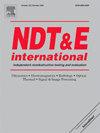Dispersion curve calculation for SH0-like guided wave locally propagating at the switch rail foot based on wave finite element method
IF 4.5
2区 材料科学
Q1 MATERIALS SCIENCE, CHARACTERIZATION & TESTING
引用次数: 0
Abstract
The switch rail is the most critical facility in the railway system for changing the direction of trains. The rail flaw detection car is difficult to detect the switch rail foot, which poses a hidden danger to the safe operation of the railway system. The SH0-like guided wave mainly with horizontal vibration is less affected by the elastic rail fastenings, which has a great potential for switch rail foot inspection. However, unlike the SH0 guided wave in flat plate, the vibration of the SH0-like guided wave in switch rail foot is more complicated. In this paper, the accurate dispersion curve calculation method for the SH0-like guided wave in the switch rail foot is proposed. Through the time domain simulation, the displacement characteristics of the SH0-like guided wave are analyzed by bending motion theory. By applying displacement constraints and fixed constraints to the local model of the switch rail foot, the accurate dispersion curve of SH0-like guided wave is solved using wave finite element method. The two-dimensional Fourier transform (2DFFT) is used for simulation and experimental verification, and the results of the 2DFFT are consistent with the dispersion curve. Defect localization by using SH0-like guided wave in switch rail foot is studied experimentally. Compared with the defect location using the group velocity of SH0 guided wave, the relative error of defect location using SH0-like guided wave group velocity is reduced by more than 8.1 %.
基于波有限元法的sh0型导波在道岔轨脚局部传播的频散曲线计算
岔轨是铁路系统中改变列车运行方向的关键设施。轨道探伤车难以检测到开关柜轨脚,对铁路系统的安全运行构成了隐患。以水平振动为主的sh0型导波受弹性轨道扣件的影响较小,具有很大的开关轨足部检测潜力。然而,与平板中的SH0导波不同,开关轨脚中的SH0型导波的振动更为复杂。本文提出了开关轨脚中sh0型导波的精确色散曲线计算方法。通过时域仿真,利用弯曲运动理论分析了类sh0导波的位移特性。通过对开关轨脚局部模型施加位移约束和固定约束,采用波动有限元法求解了类sh0导波的精确频散曲线。利用二维傅里叶变换(2DFFT)进行了仿真和实验验证,结果与色散曲线一致。实验研究了利用sh0型导波定位开关轨脚缺陷的方法。与采用SH0型导波群速定位缺陷相比,采用类SH0型导波群速定位缺陷的相对误差减小了8.1%以上。
本文章由计算机程序翻译,如有差异,请以英文原文为准。
求助全文
约1分钟内获得全文
求助全文
来源期刊

Ndt & E International
工程技术-材料科学:表征与测试
CiteScore
7.20
自引率
9.50%
发文量
121
审稿时长
55 days
期刊介绍:
NDT&E international publishes peer-reviewed results of original research and development in all categories of the fields of nondestructive testing and evaluation including ultrasonics, electromagnetics, radiography, optical and thermal methods. In addition to traditional NDE topics, the emerging technology area of inspection of civil structures and materials is also emphasized. The journal publishes original papers on research and development of new inspection techniques and methods, as well as on novel and innovative applications of established methods. Papers on NDE sensors and their applications both for inspection and process control, as well as papers describing novel NDE systems for structural health monitoring and their performance in industrial settings are also considered. Other regular features include international news, new equipment and a calendar of forthcoming worldwide meetings. This journal is listed in Current Contents.
 求助内容:
求助内容: 应助结果提醒方式:
应助结果提醒方式:


